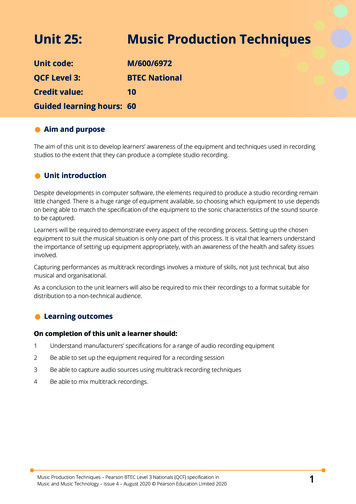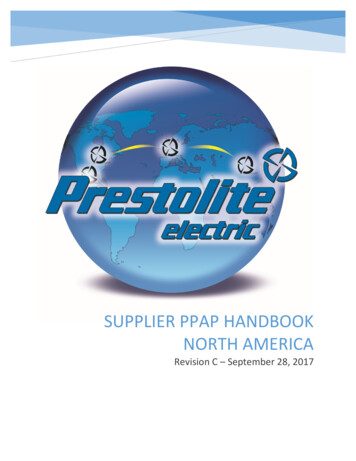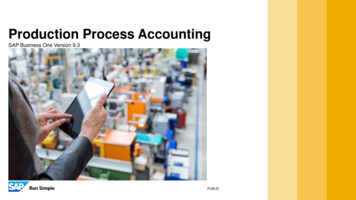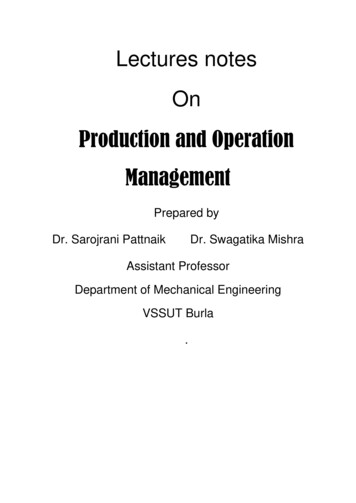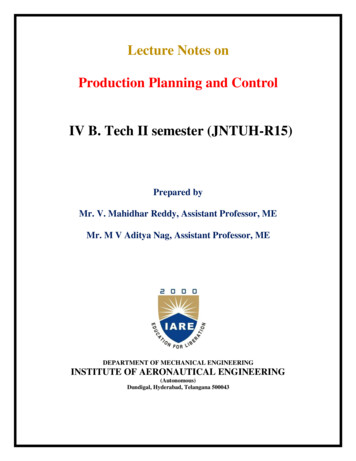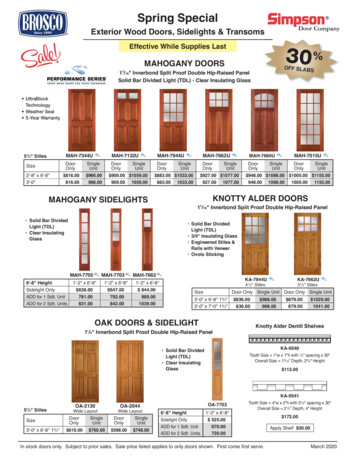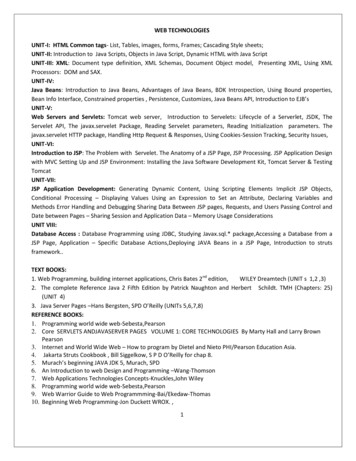
Transcription
DBA 1651PRODUCTION MANAGEMENTNOTESUNIT - IINTRODUCTION TO PRODUCTION ANDOPERATION MANAGEMENT1.1 Introduction1.2 Learning objectives1.3 System1.3.1 Business System1.3.2 Production System1.3.3 Production and Operations Managements1.4 History of operations Management1.5 Types of operation system1.5.1 Flow Shop1.5.1.1Continuous Production1.5.1.2Mass Production1.5.1.3Batch Production1.5.2 Job Shop1.5.3 Project Production1.6 Production activities and communication link1.7 Computer Integrated Manufacture ring (CIM)1.7.1 CIM sub systems1.7.2 Functional Areas of CIM1.7.2.1 Computer aided production planning1.7.2.2 Computer aided process planning1.7.3 Conceptual frame work of CIM1.7.4 Group Technology1.7.4.1 Definition1.7.4.2 History of GT1.7.4.3 Advantages of GT1.7.4.4 Organizational Suitability for GT1.7.4.5 Group technology in CIM1.8 Global Supply Chain1.8.1 Global Complexities1.8.2 How to transform into Global Supply Chain1Anna University Chennai
DBA 1651PRODUCTION MANAGEMENTUNIT - INOTESINTRODUCTION TO PRODUCTION ANDOPERATION MANAGEMENT1.1 INTRODUCTIONThis unit starts with a definition of a system. In this unit production system andits objectives are explained along with the components of a system. The history ofoperations management is portrayed. The various functions of production system andtheir interlinking are explained through a flow chart. The components of computer,integrated manufacturing and their purpose are dealt. Finally, the recent trend in theoperations, namely, Global Supply Chain is introduced in this unit.1.2 LEARNING OBJECTIVES To know the importance of the production system in an organization. To understand the link between various activities of the production system. To comprehend the history of operations management. To understand the components of computer integrated manufacturing1.3 SYSTEMIt consists of elements or components. The elements or components areinterlinked together to achieve the objective for which it exists. Eg: human body,educational institutions, business organizations.Components of a system:The input, processing, output and control of a system are called the componentsof a system.Anna University Chennai2
DBA 1651PRODUCTION MANAGEMENTNOTESFigure 1.1 - Components of a There are two types of control, namely Proactive Control and ReactiveControl.Proactive Control:When an operation is carried out on a product in a workstation, the qualityinspector goes to the workstation and inspects the product. When the samples that hehas taken for the inspection are not confirming to the quality, he stops the machine andidentifies the reason for the deviation and corrects the problem, so that the producedproduct thereafter conform to the specifications. This type of control prevents anymajor quality setback after the production. This is an example for proactive control.Reactive Control:In a planning period, usually the quality target is fixed. Suppose, an organizationfeels to fix 5% defective is safe in the targeted production quantity and assumes that atthe end of the planning period it finds that the defective output exceeds the targeteddefective products. Then, it has to find out the reason for the deviations, namely, whetherthe problem is due to the method of doing the work or the resources used in the process.Then the planner uses this knowledge to prevent any problem in the future. Thus aReactive Control is a post morterm case.1.3.1 Business System:The business organization is classified into different subsystems based on thefunctions like marketing, production/operation, finance and human resource etc.3Anna University Chennai
DBA 1651PRODUCTION MANAGEMENTFigure 1.2 – Business SystemNOTESMarketingFinanceHuman ResourceProduction/OperationEach subsystem will have more sub subsystems.1.3.2 Production / Operation SystemFigure 1.3 – Production / Operation SystemInputTransformation OutputProcess1. To produce the required quantity.CapitalMan PowerGoodsMaterialInformationObjectivesServices2. To achieve the required quantity.3. To meet the delivery time.4. Economical way of doingOperations ManagementOperation system is either manufacturing sector or service sector. The inputrequirements are shown in figure1.3 The transformation process, in which part of thevalue addition takes place to get the required quantity of the product or services withthe targeted quality within the specified time period, is carried out in a most economicalway. Operation Management Plan coordinates and controls all the activities in theoperation system to achieve the stated objectives.Thus (the activities listed in the diagram) the Operations Management activities,ensure the objective of quantity, quality, delivery time and economical way of doingwork. The communication link between the various activities are shown in the figure1.3.Each activity is dealt in detail in different sections of this material. This figure(figure1.3) will be very much appreciated after getting a clear understanding of all theactivities.Anna University Chennai4
DBA 1651PRODUCTION MANAGEMENT1.3.3 What is operation management (OM)?NOTESOperation Management is a way or means through which the listed objectivesof an operating system is achieved. There is always a confusion between the word OM& PM (Production Management). It is accepted norm that OM includes techniqueswhich are enabling the achievement of operational objectives in an operation system.The operation system includes both manufacturing sector as well as servicesector, but when you use the word PM, you should be careful to note that it refers tothe manufacturing sector but not the service sector. Suppose, you are designing a layoutfor the hospital you should say that you are applying Operations Management Techniquenot the Production Management Technique.When you design a layout for a manufacturing sector you can say that you areapplying Production Technique or Operation Technique or vice versa.From, the above discussion we can come to a conclusion that productionmanagement is a subset of Operations Management.Review questions –1.What are the components of a system?2.What are the differences between the Production Management and the OperationsManagement?3.List the objectives to be fulfilled by an Operation System.1.4 HISTORY OF OMTable 1.1 – History of OMYear /Period of Concept/Tools and System lution of Production system18thCenturyNew Technology for Production ProcessManagementAdam Smith andharles Babbage1895Scientific Management Principles (Work Study)Motion Study for Psychological FactorsActivity Scheduling ChartGanttF.W.T. TaylorFrank & LillianGilbreth Henry1935Hawthrone Studies of Worker MotivationElton Mayo1950’sOperation Research for Decision Making Longterm Medium term, Short term decision byMany Researcher5Anna University Chennai
DBA 1651PRODUCTION MANAGEMENTCritical Path Method (CPM), Program Evaluationand Technique (PERT), Waiting-Line TheoryNOTES1970’sComputers for Inventory Control MaterialResource Planning (MRP)IBM, JosephOrlicky,Oliver Wieght1980’sJust In Time (JIT), Total Quality Control (TQC)Kanban System, CAD/CAM, ComputerIntegrated Manufacturing (CIM) FlexibleManufacturing System (FMS)Toyota1990’s1.Total QualityManagement (TQM), Concurrent (CIM),Engineering, Value Engineering2. Business Process Engineering3. Supply Chain ManagementAsqc(U.S.). IOS(England),Michael HammerOracle, SAP(Germany)2000’sLogistics, Enterprise Resource Planning (ERP),E-Commerce, E-BusinessReview questions 1. What is the contribution of GANTT?2. Who is the father of Scientific Management?1.5 TYPES OF OPERATION SYSTEMThe type of Operation System to be adopted should be known to the people,and then only you may choose the system based on the nature of the product that youare going to manufacture. The types of operation system are classified based on thefollowing criteria.Product flow pattern in conversion systemOutput of the productSpecification of the outputFigure 1.5 - Types of Operation SystemProduction Flow PatternOutput of the productSpecification of the outputCustomizedFlow shopContinuousProductionAnna University ChennaiJob shopBatchProductionFlow shopMassProduction6GoodsServicesStandard
DBA 1651PRODUCTION MANAGEMENTThe characteristics of the Operation System based on the product flow pattern:NOTES1.5.1 Flow ShopIn this kind of production, the productive resources are arranged according tothe sequence of operation required by the product design.Assume that you are engaged in the ready to wear clothing, if you want toadopt the flow shop production, then the productive resources are kept according tothe sequence of operations required by the product likeCuttingJoining by sewingAdding, buttons, zippers etcQuality checkingPackagingMostly Flow shop production are adopted when there is untapped market for theproduct, customers are price sensitive and more competition in the market.Flow shop production as shown in the figure is further divided into ContinuousProduction, Mass Production and Batch production.1.5.1.1 Continuous ProductionThe industries involved in the following activities are classified as Continuous Production Oil refining.Fertilizer production.Chemical processing etc.In this type of production the product flows continuously without muchinterruption.This type of production lacks in flexibility.1.5.1.2 Mass ProductionThe industries involved in the following activities are classified as the Mass ProductionIndustries:Auto ManufacturingTV ManufacturingCigarettesThis kind of flow shop produces the same type of output, it has little flexibility comparedto Continuous Production.1.5.1.3 Batch ProductionThe industries involved in the following activities are classified as the IntermittentProduction. Shoe manufacturing Bottling plant Cloth manufacturing7Anna University Chennai
DBA 1651NOTESPRODUCTION MANAGEMENTHere the basic design of the product is the same but the specification of the productdiffers. The production gets interrupted when the system switches over to other typeof the product specification. The products are similar in nature but not identical.The Characteristics of Flow Shop Production:Refer Table1.2Table 1.2 - The Characteristics of Flow shop ProductionProductThe products are standardized.ConversionSpecial purpose equipments, designed for the specificResourcesprocess of the product.Work forceSpecialized people, doing the repetitive jobs.WorkforceJob satisfactionJob satisfaction among the employee is low because ofthe repetitive nature of job, results in boredom, moreturnover and absentees.Work-in-progressinventoryProductive resources are balanced that result in less workin progress inventory.Cycle timeCycle time per unit is relatively lowCost of productionCost of production per unit is relatively low.Quantity of productionComparatively quantity of production is moreVarietiesProducts to be produced of less variety.FlexibilityThis kind of production lacks in flexibility.Small change in the product design needs the change inproduction system abnormally.Production planning andcontrolSince less varieties of product are produced for longerperiod, the production planning and control activities areinbuilt in the system itself, so the production planning andcontrol activities are not a complex one.1.5.2 Job ShopIn the case of Job Shop Production, the products are mostly customizedproducts. Based on the customer requirements, the products are produced. Theproductive resources are kept according to the function.Anna University Chennai8
DBA 1651PRODUCTION MANAGEMENTThe industries involved in the following activities are classified as the Job Shop production: Auto repairing Hospital Machine shopThe Characteristics Of Job Shop Production.Table 1.3ProductThe products are of order based mostly non standardized.Conversion of ResourcesGeneral purpose equipment, grouped according to theirNOTESfunctions.Work ForceSkilled people, doing multi skilled work.Work force satisfactionJob satisfaction among the employee is high because theoperator role is multifaceted.Work in ProgressThere is lot of waiting time for the product to beInventorymanufactured in the system that results in more in processinventory.Cycle timeBecause of more waiting time for the product in theproduction line that results more manufacturing cycle timecomparatively.Cost of ProductionCost of production per unit is relatively high.Quantity of productionSince it is order based production, quantity produced perunit type is relatively less.VarietiesThe production system capable of producing more type ofproducts.FlexibilityThis system has more flexibility any change in the designof the product could be incorporated without much problem.Production Planningand ControlThe arrival, the operations demanded and the operationstime required by the order mostly uncertain. This makesthe jobs of production planning and control difficult.1.5.3 Project ProductionThis refers to the industries involved in the production of one type of complexproducts like, ship construction, dam construction, bridge construction, research anddevelopment etc.9Anna University Chennai
DBA 1651NOTESPRODUCTION MANAGEMENTProject production consists of many activities where the activities are interlinked,time phased and resources committed.In this kind of production, scheduling the activities is important so that you cancomplete the project within the time and budget constraint. The resources, namely,manpower, machines, material are brought to the workplace where the product ismanufactured. There is no movement of the product.Review Questions1.2.3.4.Which type of the production system in the process inventory is less?In which type of production system flexibility is more?Tell the important characteristic of Batch Production about the product?In which type of production system there is no product movement?1.6 COMMUNICATION IN POMAs it is mentioned in the above section, operation management is meant toachieve the objectives for which the operation system is intended for. Based on theobjective set by the top management, the system design is established. The systemdesign involves designing the product and process, designing the methods, measuringthe work, identifying the location, and designing the layout. By keeping the systemdesign as a framework in the aggregate planning various production alternatives areanalyzed and the best feasible production alternatives are chosen.Then keeping the aggregate planning as a input, resource allocation andsequencing of day to day activities are done. The inventory also kept at minimum tosatisfy the organization’s inventory objectives. The maintenance activity ensures theavailability workstations. Quality control ensures the quality in the input, processing andoutput stages of production system. (See figure 1.4- Communication in POM).Review Questions1. List the activities in system design?2. What are the phases of scheduling?Anna University Chennai10
DBA 1651PRODUCTION MANAGEMENTNOTESFigure 1.4- Communication in POMExternal: Socio, Political, Economic HumanResource PolicyProductionPolicyForecastingLong term forecastTop M ana ge me ntTop Management StrategySystem DesignProduct DesignForecastingCapacity PlanningAggregate PlanningProcess DesignPlant location & layoutInventory ControlWork Design and measurementSchedulingMaintenanceQuality powerP r o d u c tio n S y s te mShort termO p e r a tio n M a n a g e m e n tMedium term forecast1.7 COMPUTER INTEGRATED MANUFACTURINGAND SERVICE SYSTEMComputer Integrated Manufacturing (CIM), a strategic thrust, is an operatingphilosophy. Its objective is to achieve greater efficiencies within the business, acrosswhole cycle of product design, manufacturing and marketing. International competitionhas intensified the requirement for high quality products that can compete in the globalmarket place. As a result of this increased competition, the pace of development hasbeen quickened and thus forcing manufacturers to enter into an era where the continuous11Anna University Chennai
DBA 1651NOTESPRODUCTION MANAGEMENTquality improvement is maintained as a matter of survival, not simply being competitiveAs the time scale of product life cycle has decreased and the demand for the qualityincreased, attention has focused on improving the product quality and promoting thecompetitive ability of industries through better design, manufacturing, management andmarketing.Global manufacturing industry is now undergoing a rapid structural change. Asthis process is continuous, manufacturing industry is encountering difficulties as it confrontswith a more changed and more competitive environment and also the market place. Inorder to share the international market, manufacturers need to implement two strategies.The first is, to improve the Enterprise Management. The second one is, to develop andapply a Systematic and Scientific Technology, i.e., CIM.With the rapid growth of the complexity of manufacturing process and thedemand for high efficiency, greater flexibility, better product quality and lower cost,industrial practice has approached the more advanced level of automation. Nowadays,much attention has been given by both industry and academia to CIM.Currently, most of the industries have highly automated facilities. To stimulateindustrial companies for utilizing the newest manufacturing technology, this has compelledto develop a system architecture that does not only replace the existing manufacturingfacilities, operational environments, but effectively utilizes the knowledge and facilitiesthat are available in the industry.To overcome the difficulties and solve the problems mentioned above automatictechniques and methodologies should be Introduced into real industrial manufacturing.1.7.1 CIM SubsystemsSignificant progress has been made in the manufacturing technology in recentyears. Numerically control machine tools, automated material handling systems andcontrolled systems have been widely used in industrial companies. The FlexibleManufacturing System (FMS), Computer Integrated Manufacturing (CIM) or Systemsor Automated Manufacturing Systems (AMS) can be attributed to and increasing numberof companies. The advancing manufacturing and computer technology has brought newchallenges to the designers of products, processes and system as well as to the managers.The traditional design and management tools can not effectively cope with problemsarising in the modern manufacturing systems.Anna University Chennai12
DBA 1651PRODUCTION MANAGEMENTNOTES1.7.2 Functional areas of CIMCIM system has emerged as a result of the development in manufacturing andcomputer technology. The computer plays an important role integrating the followingareas of CIM system. Part (component) and product design Tool and fixture design Process planning Programming of numerically controlled (NC) machines, materialhandling system (MHS), etc. Production planning Machining Assembly Maintenance Quality control Inspection Storage and retrievalTo emphasis the computer aspects, the terms Computer Aided Design (CAD),Computer Aided Process Planning (CAPP), Computer Aided Manufacturing(CAM), Computer Aided Quality Control (CAQC), Automatic Storage Retrieval(ASR), have used. Each term refers to one or more of the listed functional areas. CADrefers to the part and product design and tool and fixture design, CAPP refers to ProcessPlanning, CAM refers to the programming of manufacturing hardware, productionplanning machining, assembly and maintenance, CAQC refers to the quality controland inspection and ASR involves the storage and retrieval of raw materials, finishedproducts work in process inventory.The computer plays a leading role in the automation and integration of hardwarecomponent i.e. machines, material handling carriers and the software components ofmanufacturing systems. In order to understand the CIM subsystems and the importanceof integrating them, it is first necessary to explore the functional areas by these subsystems.1.7.2.1 Computer Aided Production PlanningProduction planning involves establishing production levels for a known lengthof time. This forms the basis for the following two functions:1. Material requirement planning2. Loading and schedulingBased on the information regarding the type and quantity of parts or productsto be manufactured, the materials required to produce the parts or products must beordered with an appropriate lead time to ensure their availability for production. Thisfunction constitutes material requirement planning. Based on the material required,capacity- for example, machine hours and labor hours can be calculated.13Anna University Chennai
DBA 1651NOTESPRODUCTION MANAGEMENTMachine loading involves assignment of parts and products to machines andmachine cell in order to distribute the production loads. Scheduling determines thesequence in machines perform the operations.1.7.2.2 Computer Aided Process PlanningProcess planning for a part involves the preparation of a plan that outlines theroutes, operations, machines and tools required to produce the component. Since theprocess is a tedious task, there has been a trend to automate it. As a result, a numbersystems have been developed. There are three basic approaches to the automatedprocess planning. They are a. Variant Approachb. Generative Approachc. All based ApproachCIM SubsystemsIntelligent ManufacturingDevelopment in artificial intelligence has had an impact on the manufacturingsystems. All most all the areas of the computer integrated manufacturing have beeneffected by the artificial intelligence. Researchers and engineers are developing theintelligent systems ranging from application in machining and assembly to long termplanning.1.7.3 Conceptual framework of CIMThe conceptual framework of CIM is shown in Figure.1.6 are six major beingintegrated by computing technology. Note that one of these is Group Technology (GT).Figure 1.6 – Conceptual framework of ICSCOMPUTERAIDEDMANUFACT.[CAM]Anna University ChennaiMANUFACT.PLANNING &CONTOL[MPC]14
DBA 1651PRODUCTION MANAGEMENTAccording to Arthur D.Little and Co., GT is the important technology amongthe others and it will play a major role in the factory of the future. The GT concept isconsidered a center road towards a higher level of CIM.NOTES1.7.4 Group TechnologyGroup technology (GT) is a concept that is currently attracting a lot of attentionfrom the manufacturing community. GT offers a number of ways to improve productivityin the batch manufacturing. The essence of GT is to capitalize on similarities on recurringtasks. GT is, very simply, a philosophy to exploit similarities and achieve efficienciesgrouping like problems.1.7.4.1 Definition of GT“Group technology is the realization that many problems are similar and that,by grouping similar problems, single solution can be found to a set of problems, thussaving time and effort”1.7.4.2 History of GTPrior to 1913, the era of Henry Ford and his model T, all machining modelswere similar to our present job shop techniques with machines laid out usually in lines orblocks of similar machines. The work was loaded onto the machines usually by themanual progress control system. Ford introduced the assembly line and that, in turn, ledto automated transfer machines. However, the majority of engineering do not produceitems in quantity that justify such methods and so the jobbing shop philosophy continued.GT is mainly a coordination of normal good engineering practices. It is impossible tosay who first practiced GT. There are reports of it having been used in Germany in the1930s.In an international Conference held in Stockholm in 1947, the basic groupswere explained by C.B.Nanthorst. In Italy M. Patrignany was an early exponent of thistechnology. However, little of this appears to have been in English. First publishedwork was from the USSR by S.P.Mitrofanov in 1959 and there after subsequent bookswere published by F.S.Denyanyuk and E.K. Ivanov.The first reported work on GToutside Russia was done by a French Forges et Ateliers de Construction Electriques deJeurmont - and this was about in Machinery in 1962. Subsequently, several Britishcompanies conducted considerable work in this field. There have also been considerablestudies done by various consultants in the Universities. The significant contribution byJ.L.Burbidge in the 1 960s led to GT as A total Manufacturing Philosophy.15Anna University Chennai
DBA 1651NOTESPRODUCTION MANAGEMENT1.7.4.3 Advantages of GTAccording to Burbidge, following are the advantages after introducing GT inmanufacturing.a. Short throughput times because machines are closed together.b. Better quality because groups complete parts and the machines are closed togetherunder one foreman.c. Lower material handling costs because machines are closed together under oneforeman.d. Better accountability because machines complete parts. The foreman can be maderesponsible for costs, quality, and completion by due date.e. Training for promotion for promotion since GT provides a line of succession, becausea group is a mini-department.f. Automation GT is a first evolutionary step in automation.g. Reduced set up time since similar parts brought together on the sameh. Morale and job satisfaction since most workers prefer to work in groups.Studies undertaken by N.L.Hyer indicate the following significant savings afterimplementing GT Snead prepared a summary matrix, listing the benefits listing benefitsachieved for the various GT.Table1.4 - Advantages of GTApplications implemented set up time20-60%Planned labor15-25%Tooling20-30%Rework & scrap15-75%Machine tool expenditures15-75%WIP carrying costs20-50%1.7.4.4 Organizational suitability for GTThe suitability of a firm for the introduction of GT depends on several factors.The survey of Willey and Dale give a tentative description of a company profile likely toachieve the greatest benefits from GT, some of these are:Anna University Chennai16
DBA 1651PRODUCTION MANAGEMENTa. The company must be a relatively small organization with a reasonably small machinetools, and manufacturing equipment.NOTESb. The company should not be typified by either large or small component variety.c. The batch sizes and the batch size range of products of the companies it is relativelysmall.Athersmith and Crookall Rajagopal and Smith Gupta Andand Grayson havesuggested another way of finding out the suitability of GT for a batch production industry.Computer simulation has been used by the effect of introduction of GT in the batchproduction industries based on the parameters such as throughput time, WIP inventoryand plant utilization Further GT is considered a desirable stepping stone for establishingJust-In-Time production.1.7.4.5 Group Technology in CIMOne may question whether a cellular concept is applicable to CIM systems.Some studies have shown that grouping machines to machine cells may limit themanufacturing system flexibility. However, industrial applications have proven that it isvirtually impossible to implement a large scale CIM subsystem using a cellular concept.Here after, the automated manufacturing systems that cellular approach can be calledas, Cellular Automated Manufacturing (CAMS). Four crucial factors of CAMS asidentified by Kusiak are:1. Volume of informationVolume of information a large-scale CIM subsystem is typically large, and it istoo expensive to effectively process information without the system’s decomposition.2. Material handling systemIn a typical CIM subsystem, automated material handling carriers are used(AGVs and Robots). Each of the two carriers can tend a limited number of machines.3. Technology RequirementSome machines have to be grouped together due to technological requirements.For example, a forging machine and a heat treatment section.4. ManagementAlthough in most of the currently CIM subsystems, the degree of automation ishigher than in classical manufacturing systems, humans will be, for a long time, an integral17Anna University Chennai
DBA 1651NOTESPRODUCTION MANAGEMENTpart of these new manufacturing systems. Due to limited size of each machine cell, aCAMS is easier to manage than the entire system.Review Question:Following stands for :1. CRM 2. FMS 3. AMS4. AS/RS 5. CAD 6. GT1.8 GLOBAL SUPPLY CHAINEven though the countries fought for border issues, but there is no trade barrierfor the trade is concerned. GATT agreements and WTO paves the way for the GlobalSupply Chain in trading. (See Figure1.7).Overall Objective of Global SupplyThe objective of global supply chain configuration is in meeting or exceedingworldwide customer (internal and/or external) expectations at the lowest cost.Specific Objectives and Expectations of Global SupplyAchievement of the transformation of supply chains into value chains will normallyinclude some combination of the following objectives and expectations: Leverage spend (across business units and geographic boundaries). Align Incentives for integration of activities (buyers, suppliers, end-users) to supportorganizational goals and strategies. Optimize supply chain operation (no. of members, capabilities, costs). Reduce inventories across the chain. Reduce all costs (item costs and supply chain operational costs). Assurance of supply of right quality items to support operations.Anna University Chennai18
DBA 1651PRODUCTION MANAGEMENTNOTESFigure 1.7- Global Supply Chain in tradingCountry ASupplierCountry rManufactur
Production planning and Since less varieties of product are produced for longer control period, the production planning and control activities are inbuilt in the system itself, so the production planning and control activities are not a complex one. 1.5.2 Jo b Shop In the case of Job Shop Producti


